Royal Mews

Beez Neez now Chy Whella
Big Bear and Pepe Millard
Mon 21 Aug 2017 22:17
|
The Royal
Mews
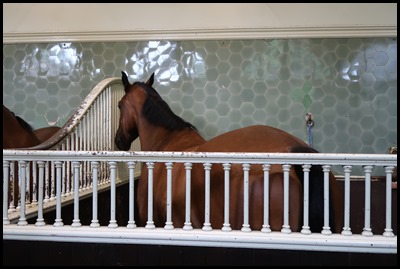 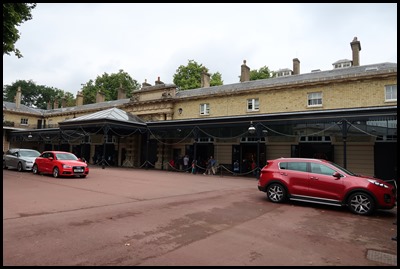 We stepped in through the main doors
to the Royal Mews, with no bags to have checked, we passed through the security
arch quite quickly...........Two horses in stalls
just after we picked up our audio equipment flatly refused to look at the camera
but they were rather handsome beasts. Stepping out, we were in a huge space.
Four sets of similar buildings formed a square around the courtyard. The side
shown in the picture houses the Royal
Carriages.
 Reserved sign. The buggers get
everywhere........... Mmmmm.
 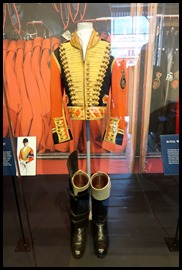 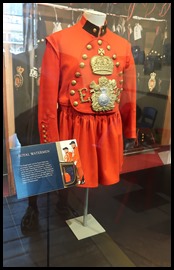 What is a
Mews ??? Richard II was the first king known to have established a
permanent home for his hunting falcons and hawks at Charing Cross, one mile from
the Royal Mews. The birds were kept there whilst they were ‘mewing’ or losing
their feathers, which happened naturally with the changing seasons but made them
temporarily unable to hunt. Henry VIII was probably the first monarch to combine
the hunting birds’ accommodation with horses, and after this the name stayed
although the falcons and hawks are long since gone.
After George III purchased
Buckingham House, now known as Buckingham Palace, in the 1760s, he quickly built
the Riding School. His son, George IV, permanently moved the royal horses from
Charing Cross to here in 1825. Originally there was space for 100 horses, and
today there is still space for over 70. The Carriages get their own blog
for now we take in some of the uniforms and head to
the tack room.
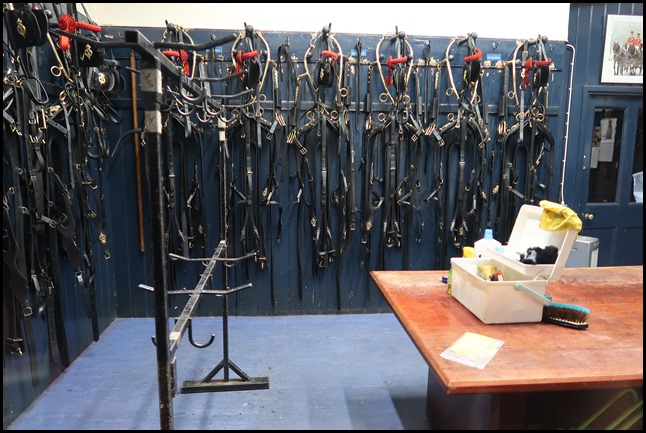 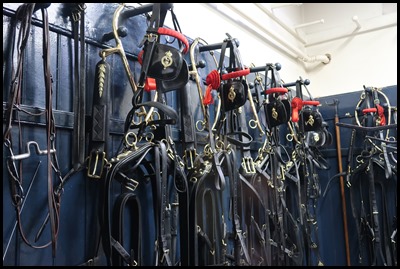 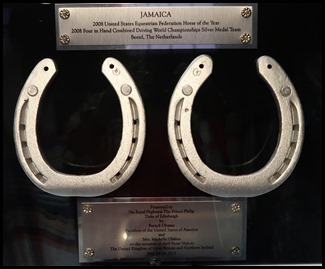 Immaculate
tack and a personal presentation from
President and Mrs Obama to HRH Prince Philip.
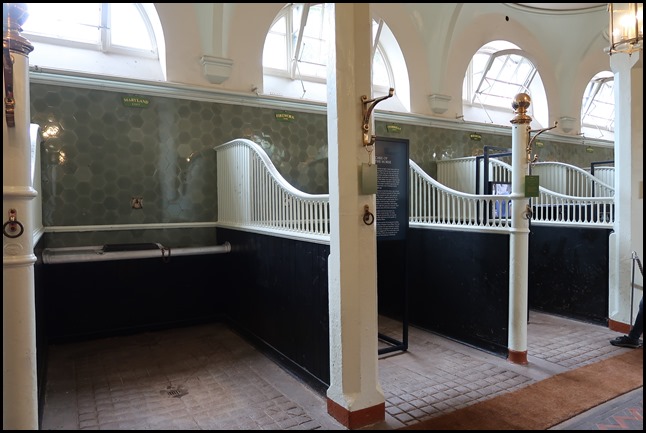 In to the
beautiful State Stables with loads of information boards.
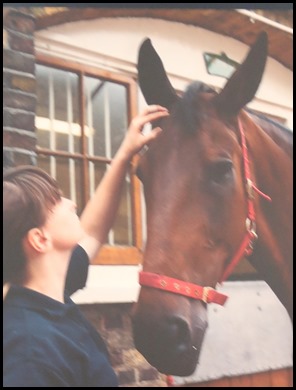  Life at the Royal
Mews: Daily Schedule.
06:00 Remove
soiled shavings (mucking out), replenish water and haynets, remove rugs in
winter, groom and prepare the horse for exercise.
06:45 An early
exercise for some of the horses. Everyone who is exercising needs to be ready in
the yard. Exercise can be riding or driving local roads, riding in the nearby
parks or in the Riding School.
08:00 Horses have
first feed.
09:00 Mucking
out, fresh water given to the horses.
09:30 Remaining
horses will be exercised
11:00 Turn in and
washdown exercised horses.
12:00 Staff lunch
break
14:00 Continue cleaning harnesses
and tack and prepare for the next day. Groom horses and provide fresh
haynets.
16:00 Crown Equerry or Head
Coachman’s Walk Round.
16:15 Coachman’s debrief and
final feed to the horses.
19:00 Night duty starts,
finishing at 06:00 the following morning.
Care of the
Horses: The horses are kept in loose boxes which are large enough for
them to turn around in and lie down if they wish. They can see over the
partitions and listen to the other horses and people around them. In the past,
horses in the State Stables were kept in standing stalls wearing a headcollar
attached to their manger. This is no longer considered appropriate and the loose
boxes were introduced several decades ago.
The horses are fed three times a
day and eat a mix produced especially for them which contains nutrients for
their work type and level. The feed is supplemented by hay or haylage, fed to
them in large haynets. Hay is long grass which has been mowed and dried for use
as an animal feed, while haylage is also made from grass, but is less dry which
preserves more of the fibre and protein.
The floors of all the loose boxes
are covered in wood shavings. The soiled shavings are removed daily and recycled
to London allotments and the garden at Buckingham Palace.
During the summer the horses go
on holiday to stables at Hampton Court Palace. They also move between the royal
residences, travelling in a horsebox, throughout the year according to royal
engagements. The horses often travel to Windsor Castle and occasionally to the
Palace of Holyroodhouse in Edinburgh.
   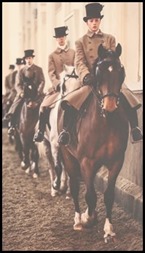 Naming the
Horses and the Mews ‘Breeds’: Most of the horses’ names are specially
chosen by The Queen. They are often named after places Her Majesty has visited,
royal names or military ranks.
Today there are two types of
horses at the Mews. The Windsor Grey has been bred by the royal family since the
nineteenth century, most of the greys are Irish draught horses,
specially selected for the Royal Mews due to their coat colour. The other breed
is the Cleveland Bay, which originates from Yorkshire. The Cleveland Bay was
developed as a riding and driving horse, used to carry people and goods across
the hills of northern England. Today it is an endangered breed and The Queen’s
use of these horses has contributed greatly to their prominence and
survival.
Handling: Handling of the young horses first takes place at
the stud at Hampton Court Palace. Horses are the broken-in (trained) at Windsor
Castle. The training for each horse is specially tailored so they become used to
a bridle and saddle. The horses start training just before they are four years
old and most will accept a rider on their back after six weeks. They are then
introduced to harness work and being driven, so they can be used to pull
carriages.
Training: When the horses are living at the Royal Mews they
are exercised in the Riding School, in the nearby James’s Park and on local
roads. Training in the Riding School enables the staff to improve their
horsemanship in a controlled environment as well as teaching the horses specific
movements, such as lunging, which involves exercising the horses on a long line.
This improves the horse’s flexibility and their familiarity with vocal
commands.
The Riding
School: The Riding School was built soon after George III purchased
Buckingham House, now known as Buckingham Palace, in 1762. At this time the
horses’ stables were at the other end of the Mall, close to Charing Cross, and
were moved here when the Royal Mews was built in 1825. This school has been used
by many generations of the royal family, both by children learning to ride and
monarchs practising before great state occasions. Queen Victoria enjoyed riding here when she first became queen, later
watching her husband Prince Albert in his new horses purchased from Germany, and
her nine children learning to ride on smaller ponies.
  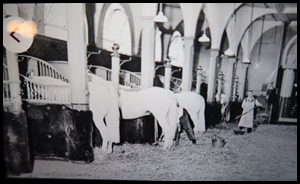 Harley noticed a really good thing to
do on our audio screen. The first picture – of the State
Stables in modern times - when rubbed, disappeared and was replaced by a
picture from yesteryear.
 Life at the Royal Mews: Jobs,
Roles and Trades. In some ways life at the Royal Mews has not changed for
centuries, although in recent times modern innovations in horse care, carriage
building and motor vehicles have been embraced. Many of the jobs at the Mews
have existed for hundreds of years, with the role of the Master of the Horse
dating back to the fourteenth century.
Techniques and skills have also
been handed down from master to apprentice. Some of the Mews staff are third and
fourth generation. Most of the staff live on site with their families, in housing located above the stables, harness rooms and coach
houses, making this a very special community in central London. Queen
Victoria during a visit to the Mews, asked where the staff families lived, when
told off site she immediately ordered the housing to be built.
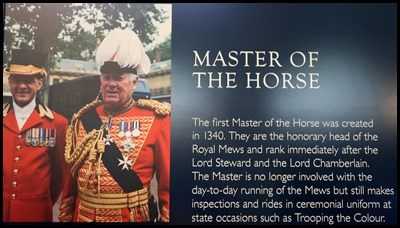 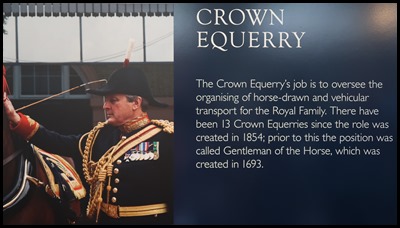 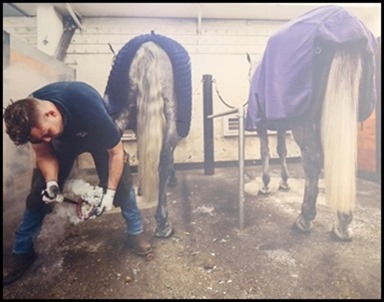  Farrier: The farrier visits each horse at least every five
weeks to fit new shoes, each horse’s hoof is also checked daily by their grooms.
The outside of the horse’s hoof is made of the same material as human
fingernails and needs trimming. The shoes protect the hooves and legs when the
horses work on roads.
Saddler: The saddlers work with all leatherwork on the
bridles, saddles and harnesses. The State Harness is particularly important with
some of the oldest components still in use today, almost three hundred years
after their creation. There are three part-time saddlers at the Royal Mews who
in recent years have won Best in Show at the Society of Master Saddlers National
Saddlery Competition.
The tools and processes used in
making saddlery has remained the same for several centuries and everything is
done by hand. The saddlers’ skills extend to other leatherwork in the Mews
including boot tops and cockades – the fan embellishments on
hats.
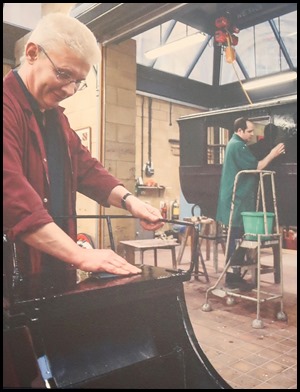 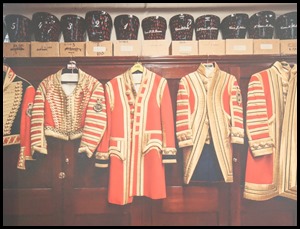  Carriage Restorer:
The carriage restorers are responsible for the overall maintenance of the
carriages, including repairing nicks and scratches sustained whilst being driven
on the roads, and undertaking a constant programme of restoration and
maintenance to ensure the carriages look their best for every state occasion.
Their knowledge and skills are passed down between members of staff as there is
no longer any formal training courses for their work. The Senior Carriage
Restorer is a fourth generation member of the Royal Mews staff and trained over
a five-year apprenticeship – the feed barrow on display in the State Stables was
his apprentice piece.
All painting is carried out by
hand, including the heraldry which is done by a specialist. There are usually 15
coats of paint applied to the carriages and wheels, and up to 21 coats on the
panels, including varnish. The plainer Mews carriages are easily identifiable,
painted in a dark maroon with their details outlined in red.
Store
Manager: The Store manager is responsible for the care and maintenance of
all the liveries and other supplies needed for the Royal Mews. The oldest livery
currently in their care dates fro the procession in 1919 commemorating the end
of the First World War Liveries are maintained to high standards and handed down
between members of staff as they are expensive to replace.
Coachmen and
Liveried Helpers: At the Mews there is a Head Coachman, a deputy and four
other coachmen. Each coachman has responsibility for approximately eight horses
and assisted by a team of four Liveried Helpers. The teams look after the
horses, drive the carriages and ride as postilions for state and ceremonial
occasions.
The Liveried Helpers muck out the
stables, exercise and train the horses, clean their saddles, bridles and
harnesses after every use and accompany the horses to shows and competitions.
Training rakes place on the job although new members of staff usually have some
prior experience with horses. Their jobs involve early hours and late evenings,
but every horse must be fed, watered and bedded down before the night duty
starts.
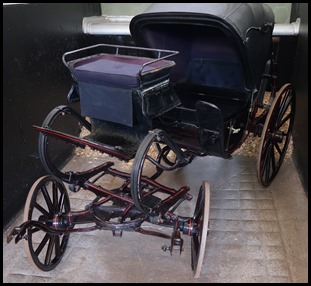  Donkey
Barouche: Queen Victoria particularly appreciated travelling in her
donkey barouche when she was older, including on holiday in the South of France
and at Osborne House, her home on the Isle of Wight. This barouche was renovated
in 1962 and was most recently used by the Queen’s youngest children at Windsor
Castle, pulled by a Shetland pony.
 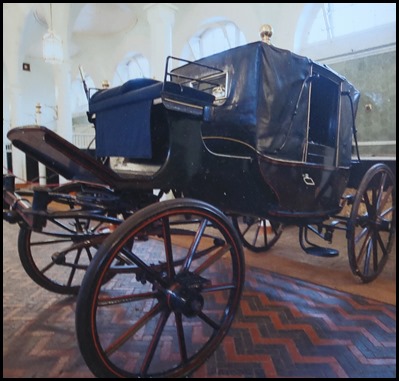 Miniature
Landau: This was presented to King George V by the Showmen of England. It
was built by Henry Hayes and son of Stamford, Lincolnshire.
 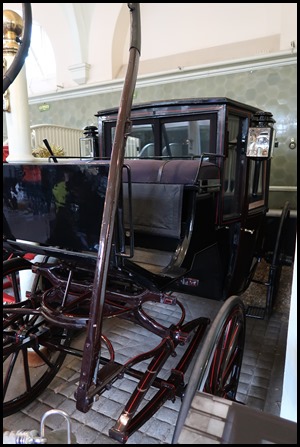   Feed
Barrow: Although this dates from the early twentieth century the barrow
is now painted with the ‘EIIR’ cypher of The Queen. The Royal Mews would have
employed a feed man to mix the horses’ feed, which would then be delivered to
the stables in this barrow. Today, the feed is prepared in each stable by the
Liveried Helpers. The barrow was restored in 1982 by the current Senior Carriage
Restorer as his apprentice piece.
 In the middle of the stables was a
carriage for visitors to try. We all got in and practised our ‘wave’. At the end of the stables
we crossed a small space to the Gold Carriage room, wow (own blog), then we made
for the exit passing the School.
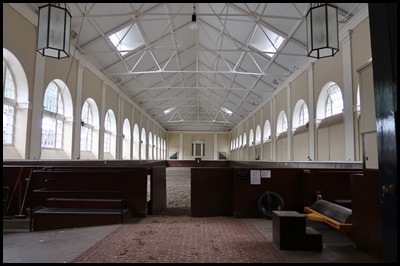  The Riding
School: After he became king, George III commissioned the architect Sir
WIlliam Chambers to design a ‘Riding House’ at Buckingham House, which was
completed in 1765-6. Not much has changed over the years, except for the
additions of electric lighting and a special surface made of recycled fibre
mixed with sand. Many sovereigns and their families have used the Riding School
(as it s now known) to practise their skills, all nine of Queen Victoria’s
children learnt to ride here. Today, the Riding School is used on a daily basis
for training the horses and riders. Time for us to make our way to
Buckingham Palace for our tour.
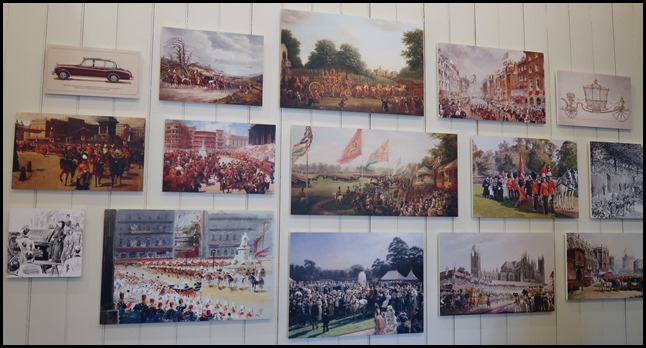  ALL IN ALL THRILLED -
SOMEWHERE I HAVE ALWAYS WANTED TO VISIT
AN AWE INSPIRING
PLACE |